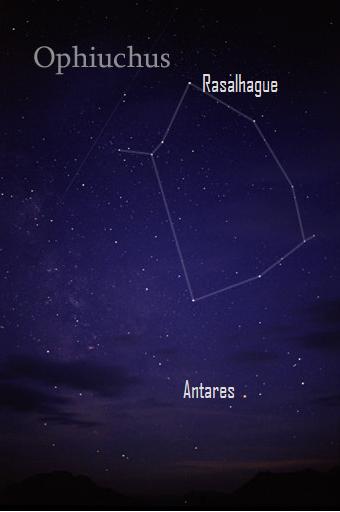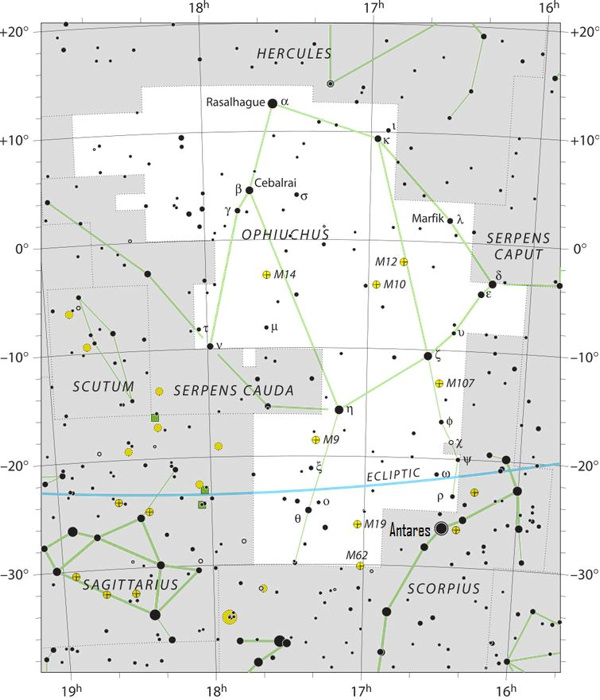

Ophiuchus holding the serpent, Serpens, as depicted in Urania’s Mirror, a set of constellation cards published in London c. 1825. Image via Wikipedia.
Born somewhere between November 30 and December 18? If so, chances are the sun passes in front of the constellation Ophiuchus the Serpent Bearer on your birthday. Now I can almost hear someone saying:
Wait a minute! There’s no Ophiuchus on the horoscope page.
You are absolutely correct. That’s because Ophiuchus is a constellation – not a sign – of the zodiac. Follow the links below to learn more about astrological signs versus astronomical constellations, when and where to locate Ophiuchus, some deep-sky treasures it contains, its mythology, its science and more.
Astrological signs versus astronomical constellations.
When and where to locate Ophiuchus.
Deep-sky objects in Ophiuchus.
Ophiuchus in myth and star lore.
Ophiuchus in history and science.

On a dark, moonless night, look for Ophiuchus above the bright ruddy star Antares. Photo via Till Credner/ AlltheSky.com.
Astrological signs versus astronomical constellations. The sun is in the sign Sagittarius from November 21 to December 21. But, in the present-day sky, the sun is in front of the astronomical constellation Ophiuchus from about November 30 to December 18. In 2019, the sun enters the constellation Ophiuchus on November 30 at 14:00 UTC (or for the U.S. Central Time Zone: November 30 at 8 a.m. CST). Then the sun enters the constellation Sagittarius on December 18, 2019, at 20:00 UTC – or at 2 p.m. CST.
Whether you’re speaking about astrological signs or astronomical constellations, the zodiac depicts the narrow beltway of stars on the stellar sphere through which the sun, moon and planets travel continuously. The zodiac runs astride the ecliptic – the sun’s yearly pathway in front of the backdrop stars. The band of the zodiac extends some 8 degrees north and south of the ecliptic, spanning a total of 16 degrees in width.
The sun is said to enter the sign Sagittarius around November 21, or whenever the sun is precisely 30 degrees west of the December solstice point. The sun then enters the sign Capricorn on the December 21 solstice. So the sun passes through the sign Sagittarius for the month period before and up to the December solstice, irrespective of the sun shining in front of the constellation Ophiuchus from November 30 to December 18.
By the way, the December solstice point moves one degree westward in front of the zodiacal constellations – or backdrop stars – in about 72 years. The December solstice point will finally move into the constellation Ophiuchus by the year 2269.
When and where to locate Ophiuchus. The best time to observe Ophiuchus is during a Northern Hemisphere summer or a Southern Hemisphere winter. From the Northern Hemisphere, late July and early August present this constellation high in the southern sky at nightfall and early evening. It’s seen in the southwest sky on autumn evenings in the Northern Hemisphere.
This rather large constellation fills the area of sky to the north of the constellation Scorpius the Scorpion and to the south of the constellation Hercules the Hero. If you’re familiar with Scorpius’ brightest star Antares, try star-hopping to Ophiuchus from this ruddy gem of a star. The head of Ophiuchus is marked by the star Rasalhague (Alpha Ophiuchi).
Ophiuchus is joined in legend and in the sky to the constellation of the Serpent. If you have a dark sky, you might find this is one constellation that looks like what it’s supposed to be: a big guy holding a snake. The name Ophiuchus comes from two Greek words meaning serpent and holding.

Can you see the Pipe Nebula a little to the upper right of center? If not, click here and put your cursor over the photo.

View larger. | Ophiuchus the Serpent Bearer. Image via Wikipedia.
Deep-sky objects in Ophiuchus. On a night when the moon is absent, take your binoculars and use them to scan Ophiuchus, which lies near the band of the Milky Way and so has many deep-sky wonders. Ophiuchus boasts of numerous globular clusters, for example. The two easiest globular clusters to see with ordinary binoculars are M10 and M12, as shown on the above chart. Through binoculars, they look like faint puffs of light, but with the telescope, you begin to see these globular clusters for what they really are. They are immense stellar cities spanning a hundred to a few hundred light-years in diameter, teeming with hundreds of thousands of stars.
Another big deep-sky favorite is the Pipe Nebula, a vast interstellar cloud of gas and dust sweeping across about 7 degrees of sky. At arm’s length, that’s about the width of three to four fingers. This dark nebula resides at a distance of 600 to 700 light-years in southern Ophiuchus, and can be seen with the unaided eye in a dark, transparent sky. The Pipe Nebula is found due east of the star Antares, and due north of the stars Shaula and Lesath. These two stars (but not the Pipe Nebula) are shown on the above chart.

The Greek Asclepius or Latin Aesculapius. The constellation Ophiuchus represents this legendary physician.
Ophiuchus in myth and star lore. In Greek sky lore, Ophiuchus represents Asclepius – said to have been the first doctor – always depicted holding a great serpent or snake. Depending on how it’s used, a snake’s venom can either kill or cure. It’s said that Asclepius concocted a potion from this snake venom, the blood of the Gorgon monster and an unknown herb to bring the dead back to life. This greatly alarmed the gods as it threatened to undo the natural order of things.
As the good doctor was trying to bring Orion the Hunter back to life, the god of the Underworld pleaded to Zeus, the king of the gods, to reconsider the ramifications of the death of death. Apparently his argument swayed the king of the gods. Zeus confiscated the potion, removed Asclepius from Earth and placed the gifted physician into the starry heavens.
We hardly know how the god of the Underworld made his appeal. Perhaps he said only that which never lives never dies, and that no mortal can have one without the other. The absence of death means the absence – not the continuance – of life. Sophocles may have expressed the myth’s inherent message when saying:
Better to die, and sleep the never-waking sleep, than linger on and dare to live when the soul’s life is gone.
Possibly, the poet T.S. Eliot reechoed the theme of the ever-living story in his Four Quartets:
We die with the dying:
See, they depart, and we go with them.
We are born with the dead:
See, they return, and bring us with them.
In any event, the association with Asclepius with snakes is why we sometimes see a staff with a serpent wound around it at doctor’s offices and hospitals, even today.

The great Johannes Kepler (1571 to 1630). The star known as Kepler’s supernova exploded in 1604, within the boundaries of the constellation Ophiuchus.
Ophiuchus in history and science. It’s been more than 400 years since anyone has seen a supernova explosion of a star within our own Milky Way galaxy. But in the year 1604, a supernova known as Kepler’s Supernova exploded onto the scene, attaining naked-eye visibility for 18 months. It shone in southern Ophiuchus, not all that far from the Pipe Nebula.
Kepler’s Supernova in 1604 came upon the heels of Tycho’s Supernova that lit up Cassiopeia in 1572. These supernovae sent shock waves into the intelligentsia of Europe, which firmly believed in the Aristotelian notion of an immutable universe outside the orbit of the moon. Tycho Brahe took a parallax measurement of the 1572 supernova, proving that it could not be an atmospheric phenomenon. In fact, the supernova shone well beyond the moon’s orbit. Shortly thereafter Kepler’s Supernova in 1604 seemed to drive home the point all over again.
Moreover, Tycho Brahe measured the distance of a comet in 1577, also finding it to be farther away than the moon. Aristotelians wanted to believe comets were gases burning in the atmosphere, but once again, Tycho threw cold water on the idea of Aristotle’s immutable universe.
Enjoying EarthSky? Sign up for our free daily newsletter today!
Bottom line: The sun lies within the boundaries of the constellation Ophiuchus the Serpent Bearer for about 2 weeks of every year, and thus Ophiuchus is an informal member of the zodiac. Astrological signs versus astronomical constellations, how to locate Ophiuchus.
Taurus? Here’s your constellation
Gemini? Here’s your constellation
Cancer? Here’s your constellation
Leo? Here’s your constellation
Virgo? Here’s your constellation
Libra? Here’s your constellation
Scorpius? Here’s your constellation
Sagittarius? Here’s your constellation
Capricornus? Here’s your constellation
Aquarius? Here’s your constellation
Pisces? Here’s your constellation
Aries? Here’s your constellation
Birthday late November to early December? Here’s your constellation
Source:
https://earthsky.org/astronomy-essentials/born-between-november-29-and-december-18-heres-your-constellation